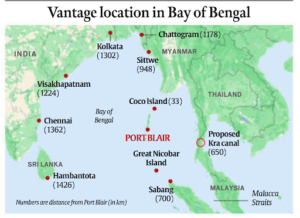
Key Points about the Islands:
- Union Territory of India, consisting of 572 islands, 38 inhabited, at the junction of Bay of Bengal and Andaman Sea.
- About 150 km north of Aceh, Indonesia; separated from Thailand and Myanmar by the Andaman Sea.
- Comprises Andaman Islands (partly) and Nicobar Islands, separated by Ten Degree Channel.
- Submerged extension of Arakan Mountains; Andaman divided into North, Middle, and South islands.
- Capital: Port Blair in South Andaman; Duncan Passage separates Little Andaman.
- Coco Strait between North Andaman and Coco Islands (Myanmar).
- Barren and Narcondam Islands: only active volcanoes in India; Saddle Peak (737 m) highest.
- Ritchie’s Archipelago, east of Great Andaman; Neil and Havelock Islands located there.
- Renaming: Ross Island as Netaji Subhas Chandra Bose Dweep, Neil Island as Shaheed Dweep, and Havelock Island as Swaraj Dweep.
- Dense tropical rainforests; Andaman home to Negrito tribes (Great Andamanese, Onge, Jarawa, Sentinelese).
- Nicobar is home to Mongoloid tribes (Shompen, Nicobarese); Negrito tribes believed to have arrived from Africa 60,000 years ago.
- Hosts Andaman and Nicobar Command, only tri-service geographical command of Indian Armed Forces.
Strategic Importance:
- Geopolitical Proximity: The Andaman and Nicobar Islands are positioned 700 nautical miles southeast of the Indian mainland, strategically located near major maritime routes.
- Control over Strategic Waterways: Located close to the Malacca Strait, a crucial waterway connecting the Indian Ocean to the Pacific, the islands offer control over this vital maritime passage.
- Influence over Regional Dynamics: Proximity to Sabang in Indonesia and Coco Island in Myanmar provides strategic leverage in regional geopolitics, particularly in Southeast Asia.
- Potential Impact of Infrastructure Projects: The proposed Kra Canal by Thailand, if constructed, could significantly alter regional dynamics, positioning the islands as a key hub in the new maritime route.
- Maritime Boundary Advantage: The islands’ position enables India to assert control over maritime boundaries, sharing borders with Myanmar, Thailand, Indonesia, and Bangladesh, thereby enhancing its maritime security.
- Expanded Maritime Jurisdiction: By extending India’s exclusive economic zone and continental shelf under UNCLOS, the islands offer substantial ocean space, further consolidating India’s maritime influence.
Why in News:
- Recently, the evolution of India’s Look East policy to an Act East policy, coupled with heightened awareness of maritime power and advancements in the Chinese PLA Navy, underscores the urgency of developing Indian island territories, especially the Andaman and Nicobar group.
 Profile
Profile Settings
Settings Refer your friends
Refer your friends Sign out
Sign out






